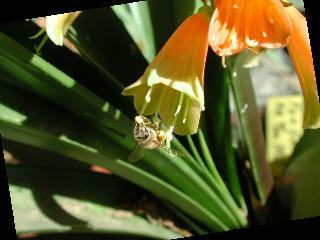 This image (2382s) and 2381ss show some bees caught in the act. I was just going to do it but they took over, I did not trust them so I did it as well.
This image (2382s) and 2381ss show some bees caught in the act. I was just going to do it but they took over, I did not trust them so I did it as well.
CliviaNet___________
for clivia lovers around the World
| CliviaNet Home |
| Clivia Overview |
| Cultivation |
| E-Mail and Chat |
| Clivia Society |
| Photo Gallery |
| Seed Exchange |
| Sources |
| Links |
Pollination even in the wild does not occur readily. We see it can be done by bees, birds do it and even educated ants do it (no not fleas). But if you are serious about offspring, do the pollination yourself.
 This image (2382s) and 2381ss show some bees caught in the act. I was just going to do it but they took over, I did not trust them so I did it as well.
This image (2382s) and 2381ss show some bees caught in the act. I was just going to do it but they took over, I did not trust them so I did it as well.
In the beginning to encourage bees to crawl into the flower and do the job I injected a dilute honey solution into the back of the floret. Not very successful. I even sprayed the whole umbel with a honey mist. No bees. Maybe if the clivia flower is more fragrant they will visit, but then I have heard it said that bees can't smell, they can only see colors.
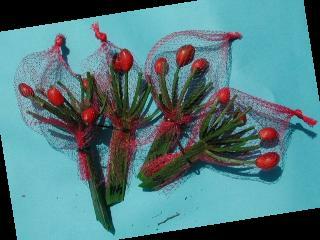 This image (3951) shows berries from the wild or just about, out of the bush on our property, very few berries, a very meagre harvest. The insect pollinated flowers on image 3951 yielded 15 seeds from 4 umbels of flowers and 14 berries, so 1 seed per berry roughly.
This image (3951) shows berries from the wild or just about, out of the bush on our property, very few berries, a very meagre harvest. The insect pollinated flowers on image 3951 yielded 15 seeds from 4 umbels of flowers and 14 berries, so 1 seed per berry roughly.
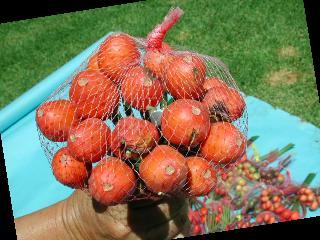 Image 3960 shows a berry head that had been hand pollinated. What a difference! Hand pollinated flowers from plant 417, image 3960 had 17 berries and 112 seeds in total. In another case plant 412 had 8 umbels of flowers with 65 berries, yielding 309 seeds. So think of all the dollars if all your plants were that prolific.
Image 3960 shows a berry head that had been hand pollinated. What a difference! Hand pollinated flowers from plant 417, image 3960 had 17 berries and 112 seeds in total. In another case plant 412 had 8 umbels of flowers with 65 berries, yielding 309 seeds. So think of all the dollars if all your plants were that prolific.
I also observed ants doing the job, image 4061. They must have discovered some natural nectar in the flowers (this time I was not guilty with the honey) but how successful they were I can't tell at this stage.
It therefore seems you will have to get up early to do the job.
 The fundi maintain that in the morning there is a very moist tip to the three lobed stigma which makes it more receptive to pollen and the pollination process. It may be that bees are not up that early and when they arrive the stigma is dry. So we need a moist stigma. This moist stigma is so important that some growers moisten the stigma with sugar water (it aids germination of pollen grain), then they place the pollen onto the sugar water-moistened stigma and a year later they have plenty of seeds to give to their friends. Some growers say you can even cut the end of the style off and add pollen to the stump, it will still end up as a successful pollination, provided you have some sugar water to aid germination.
The fundi maintain that in the morning there is a very moist tip to the three lobed stigma which makes it more receptive to pollen and the pollination process. It may be that bees are not up that early and when they arrive the stigma is dry. So we need a moist stigma. This moist stigma is so important that some growers moisten the stigma with sugar water (it aids germination of pollen grain), then they place the pollen onto the sugar water-moistened stigma and a year later they have plenty of seeds to give to their friends. Some growers say you can even cut the end of the style off and add pollen to the stump, it will still end up as a successful pollination, provided you have some sugar water to aid germination.
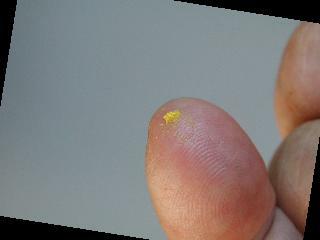 The easy way to do it is to moisten the tip of the finger , the sweet people wont have problems, touch the tip of the stigma with moist finger tip then touch the pollen sacs on the anther with the same moist finger to pick up some pollen (image 4072s).
The easy way to do it is to moisten the tip of the finger , the sweet people wont have problems, touch the tip of the stigma with moist finger tip then touch the pollen sacs on the anther with the same moist finger to pick up some pollen (image 4072s).
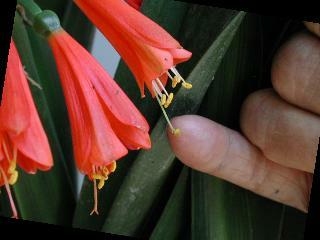 Then with the pollen stuck to your fingers touch the already moistened stigma (image 4073s). Vola! You have done it.
Then with the pollen stuck to your fingers touch the already moistened stigma (image 4073s). Vola! You have done it.
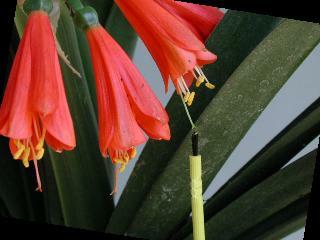 You can also moisten the stigma with your finger, pick up the pollen with a small brush and transfer the pollen to the stigma (image 4069s).
You can also moisten the stigma with your finger, pick up the pollen with a small brush and transfer the pollen to the stigma (image 4069s).
You can use tweezers, break off the whole anther with pollen sacs attached and walk through the whole garden doing your job.
Now remember, if this is done with pollen from the same flower to the stigma of the same flower, it is SELF pollination. If you carry this pollen to another flower it is CROSS pollination. You can also carry this pollen from a miniata to a nobilis, that is INTERSPECIFIC cross pollination and you end up with the beautiful hybrids that always belong to somebody else, but persevere.
They say wait till the three lobes of the stigma are visible before you pollinate, it is then most receptive. Don't pollinate if the stigma is starting to turn red or brown, either the job has been done or you are too late. So a soft moist green three lobed stigma is the thing. You may find in some flowers the stigma may protrude beyond an unopened flower Image 4068s, fine the flower wants to be cross pollinated, so do it when the stigma is ready. To further prevent cross-pollination, remove the anthers before the pollen is ripe, or slip a cut piece of a soda drinking straw over the stigma to prevent pollen reaching it.

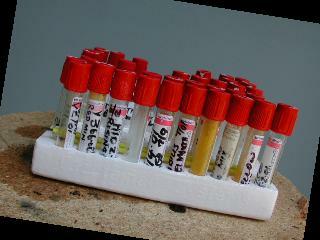 You may want to preserve some pollen because there is not a suitable recipient at that time, or you may want to cross pollinate to another clivia species. Store the pollen in a glass tube, with a few grains of silica to keep them dry otherwise they go all smutty and rotten. The tube you can beg from your Vet. they use them for drawing blood, I suppose they use the same for humans. The silica gel nowadays is used in the bottles to keep pills, capsules dry, there is a little container with silica grains in it, open it up and put a few grains into the tube or buy a new camera to photograph all your new hybrids, in there you will find a bag with silica gel or get some from the chemist/drug store. Label the tube with the date, and the name (image 4067, left) or number of the plant and put into deep freeze (image 4064, right). Remember to let it thaw before it is used on the stigma.
You may want to preserve some pollen because there is not a suitable recipient at that time, or you may want to cross pollinate to another clivia species. Store the pollen in a glass tube, with a few grains of silica to keep them dry otherwise they go all smutty and rotten. The tube you can beg from your Vet. they use them for drawing blood, I suppose they use the same for humans. The silica gel nowadays is used in the bottles to keep pills, capsules dry, there is a little container with silica grains in it, open it up and put a few grains into the tube or buy a new camera to photograph all your new hybrids, in there you will find a bag with silica gel or get some from the chemist/drug store. Label the tube with the date, and the name (image 4067, left) or number of the plant and put into deep freeze (image 4064, right). Remember to let it thaw before it is used on the stigma.
Some growers say you can only thaw them once and then throw them away. I have used them repeatedly, with no decrease in % pollination. This pollen apparently can be stored up to three years with no loss of viability, but don't just take my word for it. I now have some 2 year old pollen in the freezer that I am still using.
If you have contacts you can have the pollen bombarded with radioactive Cobalt or send to a friend in Chernobyl to keep it there for a while. This exposure to radiation can give rise to weird and wonderful flowers; that's what they tell me, that's what they say. Wow, I have said far too much for one bedtime story; all the listeners are fast asleep.
Good night,
Loukie